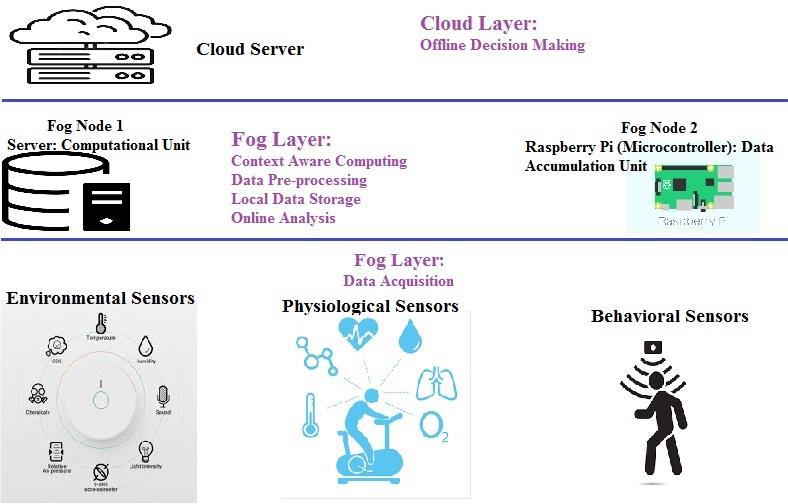Digital Companion for Elders in Tracking Health and Intelligent Recommendation Support using Deep Learning
Main Article Content
Abstract
Ambient assisted living (AAL) facilitates the daily routines of elderly people, particularly those who have clinical difficulties or physical limitations. The latest technologies like distributed compuring,internet of things (IoT) and machine learning pave the ground for the creation of an effective automated tracker which aids elder citizens to live independently. The suggested system is attempted to design a wearable that monitors the blood glucose level through sweat. To achieve high accuracy, the proposed system uses ambient sensing and deep learning based techniques. It places a strong emphasis on calculating the health index by taking into account numerous disease-related characteristics or vitals such as heart rate, blood pressure, SpO2, blood glucose level, respiration rate, sweat rate, uric acid, and temperature. From the wearable device designed the vital signs are gathered, further environmental sensors and camera fixed around the person continually monitors the behavioral pattern along with physiological signals. This ensures the improved accuracy of health state prediction from its conventional models in place. The key advantage of this device is that it may be held and operated anyplace without interrupting their day-to-day tasks because the device is to be cheap, reliable and speedy.
Article Details
References
H. Jigarkumar H. Shah and A. D. Patel, “Ambient Assisted Living Systems: The Scope of Research and Development”, In Proc. of International Conference on Electrical, Electronics, Computers, Communication, Mechanical and Computing, pp.1-5, 2018.
G. Cicirelli, R. Marani, A. Petitti, A. Milella and T. D’Orazio, “Ambient Assisted Living: A Review of Technologies, Methodologies and Future Perspectives for Healthy Aging of Population”, Sensors, vol. 21, no. (10):3549, pp. 1-22, 2021, https://doi.org/10.3390/s21103549.
R. Stodczyk, “Ambient Assisted Living an Overview of Current Applications, End-Usersand Acceptance” Biomed J Sci & Tech Research, vol. 30, no. 3, pp. 23374-23384, 2020, DOI: 10.26717/BJSTR.2020.30.004949.
V. Vimarlund, E. M. Borycki, A. W. Kushniruk and K. Avenberg, “Ambient Assisted Living: Identifying New Challenges and Needs for Digital Technologies and Service Innovation”, Yearb Medical Informatics, vol. 30, no. 1, pp. 141-149, doi: 10.1055/s-0041-1726492.
T. Gowda, B. Ganesan, A. Al-Jumaily, K.N.K. Fong, S.K. Meena and R.K.Y. Tong, “Ambient assisted living technologies for older adults with cognitive and physical impairments: a review”, European Review for Medical and Pharmacological Sciences, vol. 23, pp. 10470-10481, 2019, https://www.europeanreview.org/wp/wp-content/uploads/10470-481.pdf.
M. A. Qureshi, K. N. Qureshi, G. Jeon and F. Piccialli, “Deep learning-based ambient assisted living for self-management of cardiovascular conditions”, Neural Computing and Applications, Special Issue on Effective and Efficient Deep Learning, pp. 1-19, Jan 2021, doi: 10.1007/s00521-020-05678-w.
J. Saha, C. Chowdhury and S. Biswas, “Review of Machine Learning and Deep Learning Based Recommender Systems for Health Informatics”, In: Dash, S., Acharya, B., Mittal, M., Abraham, A., Kelemen, A. (eds) Deep Learning Techniques for Biomedical and Health Informatics. Studies in Big Data, vol 68. pp. 101-126, Nov 2019, https://doi.org/10.1007/978-3-030-33966-1_6.
L. Syed, S. Jabeen, Manimala and A. Alsaeedi, “Smart healthcare framework for ambient assisted living using IoMT and big data analytics techniques”, Future Generation Computer Systems, 101, pp.136-151, Dec 2019, https://doi.org/10.1016/j.future.2019.06.004.
S. Sankar, P. Srinivasan and R. Saravanakumar, “Internet of Things based ambient assisted living for Elderly People Health Monitoring”, Research J. Pharm. and Tech., vol. 11, no. 9, pp. 3900-3904, 2018, doi: 10.5958/0974-360X.2018.00715.1.
H. Zafar, A. Channa, V. Jeoti and G. M. Stojanovi?, “Comprehensive Review on Wearable Sweat-Glucose Sensors for Continuous Glucose Monitoring”, Sensors, vol. 22, no. 2:638, pp. 1-35, 2022, https://doi.org/10.3390/s22020638.
E. J. M. Moonen, J. R. Haakma, E. Peri, E. Pelssers, M. Mischi and J. M J. Den Toonder, “Wearable sweat sensing for prolonged, semicontinuous, and nonobtrusive health monitoring”, View, vol. 1, no. 4, pp. 1-23, Oct 2020, https://doi.org/10.1002/VIW.20200077.
P. Yang, G. Wei , A. Liu, F. Huo and Z. Zhang, “A review of sampling, energy supply and intelligent monitoring for long-term sweat sensors”, npj Flexible Electronics, vol. 6, no. 33, pp. 1-13, June 2022, https://doi.org/10.1038/s41528-022-00165-9.
M. Chung, G. Fortunato and N. Radacsi, “Wearable flexible sweat sensors for healthcare monitoring: a review”, J. R. Soc. Interface, 16: 20190217, pp. 1-15, Oct 2019, https://doi.org/10.1098/rsif.2019.0217.
F. Gao, C. Liu, L. Zhang, et al., “Wearable and flexible electrochemical sensors for sweat analysis: a review”, Microsyst Nanoeng, vol. 9, no. 1 pp. 1-21, 2023, https://doi.org/10.1038/s41378-022-00443-6.
Liping Xu, Zhibo Zhou, Mengdi Fan, Xin Fang, “Advances in wearable flexible electrochemical sensors for sweat monitoring: A mini-review”, International Journal of Electrochemical Science, vol. 18, no. 1, pp. 13-19, 2023, https://doi.org/10.1016/j.ijoes.2023.01.009.
J. Yin, J. Li, V. S. Reddy D. Ji, S. Ramakrishna and L. Xu, “Flexible Textile-Based Sweat Sensors for Wearable Applications”, Biosensors, vol. 13, no. 1(127), 2023, https://doi.org/10.3390/bios13010127.
X. Wang, J. Ellul and G. Azzopardi, “Elderly fall detection systems: A literature survey”, Frontiers in Robotics and AI, vol. 7, no. 71, pp. 1-23, June 2020, https://doi.org/10.3389/frobt.2020.00071.
A. Ramachandran and A. Karuppiah, “A Survey on Recent Advances in Wearable Fall Detection Systems”, BioMed Research International, vol. 2020, no. 2167160, pp. 1-17, 2020.
S. M. Turkane, Swapnil J. Vikhe, C. B. Kadu and P. S. Vikhe, “Automatic Body Fall Detection System for Elderly People using Accelerometer and Vision Based Technique”, International Journal of Recent Technology and Engineering, vol. 8, no. 4, pp. 85-90, 2019, doi:10.35940/ijrte.C5922.118419.
Hubert Kenfack Ngankam, Helene Pigot, Dominique Lorrain, Isabelle Viens and Sylvain Giroux, “Context awareness architecture for ambient-assisted living applications: Case study of nighttime wandering”, Journal of Rehabilitation and Assistive Technologies Engineering, vol. 7, pp. 1-13, Mar 2020, doi: 10.1177/2055668319887864.
Soo-Yeon Jeong and Young-Kuk Kim, “Deep Learning-Based Context-Aware Recommender System Considering Contextual Features”, Applied Sciences, vol. 12, no. 45, pp. 1-12, Dec 2021, https://doi.org/10.3390/app12010045.
K. Revathi, T. Tamilselvi, K. Tamilselvi, P. Shanthakumar and A. Samydurai, "Context Aware Fog-Assisted Vital Sign Monitoring System: Design and Implementation," 2022 International Conference on Edge Computing and Applications (ICECAA), Tamilnadu, India, 2022, pp. 108-112, doi: 10.1109/ICECAA55415.2022.9936287.
A. G. Gad, “Particle Swarm Optimization Algorithm and Its Applications: A Systematic Review”, Arch Computat Methods Eng, vol. 29, pp. 2531–2561, 2022, https://doi.org/10.1007/s11831-021-09694-4.
Adrian Tam, “A Gentle Introduction to Particle Swarm Optimization”, Machine Learning Matery, September 2021, https://machinelearningmastery.com/a-gentle-introduction-to-particle-swarm-optimization/.

